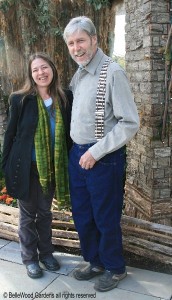The Nuts & Bolts—Er, Bark—of Creating the Holiday Train Show
Posted in Exhibitions, Holiday Train Show on December 18 2009, by Plant Talk
Sculptor Takes Us Behind-the-Scenes Building the Botanical Replicas
 Sculptor Annette Skinner has worked on the Applied Imagination team since 1992.
Sculptor Annette Skinner has worked on the Applied Imagination team since 1992.
Memories of travels, saved in a giant box. The twisty stick, obscure seed pod, shapely leaf quietly await the next decisive moment. If lucky, my boss, Paul Busse, will require my sculptural eye for the intriguing job of creating another scale model of a historic building. These varied natural objects possibly will become a banister, urn, or portico.
 Paul, designer of the Holiday Train Show, (see the two of us in the photo at right, courtesy of Judy Glattstein) has a unique concept that requires integration of the natural world with traditional G-scale model railroad layouts. His highly dimensional, textural interpretation is populated by finely detailed versions of American art and architecture. Each year The New York Botanical Garden adds to its collection of New York landmarks, and I have been helping on these starting with Poe Cottage in the early days. This year’s newcomer, Penn Station, took staff at Applied Imagination over 1,1,00 collective hours to complete. Also new this year is the Brooks Brothers flagship store, LED lights on the Yankee Stadium replica, and an audio of lovely organ music by Paul’s son, Brian, accompanying the St. Patrick’s Cathedral replica.
Paul, designer of the Holiday Train Show, (see the two of us in the photo at right, courtesy of Judy Glattstein) has a unique concept that requires integration of the natural world with traditional G-scale model railroad layouts. His highly dimensional, textural interpretation is populated by finely detailed versions of American art and architecture. Each year The New York Botanical Garden adds to its collection of New York landmarks, and I have been helping on these starting with Poe Cottage in the early days. This year’s newcomer, Penn Station, took staff at Applied Imagination over 1,1,00 collective hours to complete. Also new this year is the Brooks Brothers flagship store, LED lights on the Yankee Stadium replica, and an audio of lovely organ music by Paul’s son, Brian, accompanying the St. Patrick’s Cathedral replica.
Most of Paul’s designs are drawn in a studio he shares with his wife, Margaret Duke, in northern Kentucky. His drafting table overlooks a stream, reflecting the flow and curves of his blueprint sketches for track assembly.
Construction of the track is no small task. The shop employs a skilled crew of track builders, who begin with a spray-painted grid of the show’s layout on the gravel drive. Measurements are taken and translated into the cutting of lumber.
Replica construction begins months in advance, depending on size and complexity: A single small house can take 80 hours and a large façade, 800 hours, demanding year-round dedication.
Paul usually has an idea of whom he wants to construct each building. Cindy Johnson, Paula Edwards, Judy Eglian, Beth Lasky, and Rich Fruth, are key members of the 22-member team (12 full-timers). Paul uses rulers and pencils to draw out the shape of the building on foamboard. Each person cuts out and decorates their own house; on large replicas, panels are worked in teams.
Window edges get mossed and mullions fitted; tops and sides are created as the foundation for later grouting. Materials are guided by Paul, who has a general idea of what he wants the final product to look like. The house crew spends most days in the noisy shop taking turns at the band saw—with an air compressor going and sometimes a drill and jigsaw— fitting tiny pillars and gutters with hot glue and tweezers.
As projects progress, they begin to come to life. I find myself looking for bark or fallen acorn caps that are the right size, always collecting as I go (or looking for the next project) color or texture that approaches the scaled-up version of brick or roof tile.
As Halloween approaches the pace picks up and the work piles up on every available space in the shop. I’ve spent many peaceful evenings working by the fire once the flurry of the day’s events have settled. It’s a giant feeling of accomplishment when finished pieces are sealed and packed onto trailers for the many miles to Christmas.
After all the hard work of designing and fabricating and detailing, the puzzle is ready to come together. Several of us travel to New York to breathe life into the towers, townhouses, and mansions that will make up the Botanical Garden’s Holiday Train Show. The Conservatory’s Seasonal Exhibition Galleries are prepared so we can piece together the winding track among the collection of camillas that I watch grow larger each year.
New York artists join in as well as garden railway model train experts. Everyone shares their niche of knowledge. David Caldwell prefers erecting waterfalls; his brother Butch, the bridges. Sisters Darlene Johnston and Dinah Studer wire track to the roadbed they’ve constructed. I enjoy the landscape design work, tending to the placement of rocks, trees, and flowering plants to complement the structure and color of each building like a sculpture or living painting.
Finally, the walkway in the Conservatory is hosed off, the twinkling lights turned on, and the evening sky blazes orange and purple through the glass roof. I click photos in my mind and wish I could collect these memories like favored figments of travels past.

